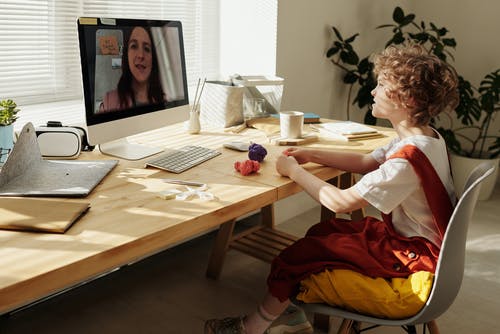

Educating our Children VI – Online Solutions

Backstory
I was wrong. Ok, I was half wrong. In an earlier commentary on educating our children I lamented the Little House on the Prairie approach to our education system. Having three kids finish their last school year as well as the fall semester online as COVID-19 pushed us away from each other and with my own experience lecturing at the University of Windsor this fall, I see things in a new light. I signed on to teach because the school needed someone with industry experience, and I saw a chance to learn some new skills.
If you don’t have time to return to my commentary from three years ago – my main thesis was that sending our kids to school at prescribed times in a physical location to listen to lectures they could easily watch online in a pre-recorded format doesn’t make sense in this modern world of technology. In addition, this old school approach just doesn’t promote health – sitting on a bus or in a car to sit in a classroom to sit in a lunchroom…
Sal Khan
My original thinking was that with so many free tools online for learning we were missing an opportunity to leverage these tools. Tim, my friend and longtime client, introduced me to Khan Academy about 10 years ago. I immediately implored my boys to start to use the tool, which was free, to get a handle on math (a decade later they cover much more than math). Of course, every kid knows that the ideas of their parents are either rooted in self-interest or just plain dumb which is why my kids didn’t figure it out for years – and when they finally did, they made sure I wasn’t looking.
Around the same time as I was playing with Khan Academy, the world was introduced to Massive Open Online Courses (MOOCs) which offered remote learning, again often for free. Fundamentally the internet was not only democratizing knowledge but was democratizing teaching. What I saw as we rounded the 2000s was a game changer for those that wanted to learn.
I concluded that anyone that wanted an education would soon be able to find it for free and on the schedule that worked best for them. In recent years I have challenged all our kids on why they want to bother wasting time and money going to university when they could just self-teach online – saving the tuition and working during non-learning hours. The math said that after 4 years they would be so far ahead economically that they would never look back.
Plot Twist
I am always looking for new ideas and watching my kids learn from home has exposed a viewpoint I previously couldn’t see. Sitting at home trying to learn online is even more difficult than trying to do the exact same thing sitting in-person at school. A crappy teacher is a crappy teacher regardless of the format – and a crappy student is an even worse student when left at home to completely tune out the learning in the room. My kids are hanging on, but they have made it perfectly clear that they miss being AT school.
My department head, Rick, summed up the whole debacle when we were discussing the current COVID-19 situation in our high schools and he said “I wouldn’t want to be a teacher, I wouldn’t want to be a student and I wouldn’t want to be a parent in this environment”. My supposition is that the younger the student the worse this experience has been compared to the pre-pandemic school arrangements each of them enjoyed.
From my side of the camera, teaching online has been tough for me. When I signed on to teach, I simply thought I would be relying on my experience standing in front of a group of people and sharing my ideas with an engaged audience. When I was told the class would be online I didn’t think much about what that meant and when I was told the students were in a masters program, I assumed that they would be as engaged as the audiences I face at our industry meetings.
To my surprise and disappointment, the audience is not as engaged as I had hoped and we are left wondering whether it is their age, their inexperience with the material, or the technological divide. Simultaneously, we have discovered that my subtle humor does not play as well when I am sitting in a 2-inch by 3-inch box on the screen in the corner of a power point presentation. In addition, after 30 or 40 hours trying to learn the teaching technology Blackboard, my skill delivering class through technology is probably in the bottom quintile of the professors at the school. All in, you have a recipe for mediocrity which is not the level to which I aspire. Student evaluations come out in a few weeks and then we will see where my performance rates – regardless I have been humbled in the difficulty of teaching during a pandemic.
Rebalancing
In a recent podcast, Sal Khan said “if I had to pick between an amazing teacher or amazing technology for myself or my own kids or anyone’s kids, I’d pick the amazing teacher, in person, any day”. I always feel a little better when I start to change my mind and I can find other smart people that have already reached the same conclusions as me.
It seems students need good teachers AND the dynamic of the in-person classroom with all its messy back and forth to truly engage in a subject and to get their mind around the material. The question is: when the pandemic is behind us should we go right back to sending the kids to school on the bus to sit in class all day? To me, it would be a shame if we didn’t use this experience to reshape how we deliver education going forward.
What I see ahead is neither 100% in-school nor 100% online. I see a mix. Surely we know that class time is valuable, so we need some of that in the mix. But do we really need our kids to sit in class to watch a teacher draw circles and triangles to explain trigonometry? I would say no – online lectures with video will probably do a better job and will certainly come at a better cost. A mixed approach might also serve students like me that get restless and are not capable of concentrating for many hours consecutively.
I think young kids will lean towards 100% in-person as teachers provide the valuable service of focusing attention and teaching critical social and communication skills. As kids get older, greater and greater percentages of the school week can be spent online consuming lectures while making sure there is still in-school time to discuss what is being learned, to allow teachers to formally and informally test learning, and to connect with friends socially.
So here is our new problem – if we only send students to a physical school 10 to 20 hours a week – who supervises them the rest of the time? We are going to have to grapple with the fact that one function of school, like it or not, is a baby-sitting service for kids that are too young to be home alone. The pandemic has put the parents of young kids in a tough spot – forced to give up their jobs or forced to simultaneously work while trying to focus the children on schoolwork.
I am not living in this world of working and supervising kids at the same time, but I am sure it is intolerable long-term. We are going to have to find a safe place for kids when not in the formal school setting. I don’t know if that means more after school programs. If you go back to that earlier commentary, part of the solution will be better community spaces such as libraries. The need for this is obvious when you look at the number of open laptops at Tims and Starbucks all day and all night. Better community spaces might also be well suited to integrate physical activities to break up a long learning session.
I am not in charge of the education – just an interested observer. It will be interesting to see what this all looks like in another decade and I hope its not as similar as Little House on the Prairie as it was in 2019.



Comments